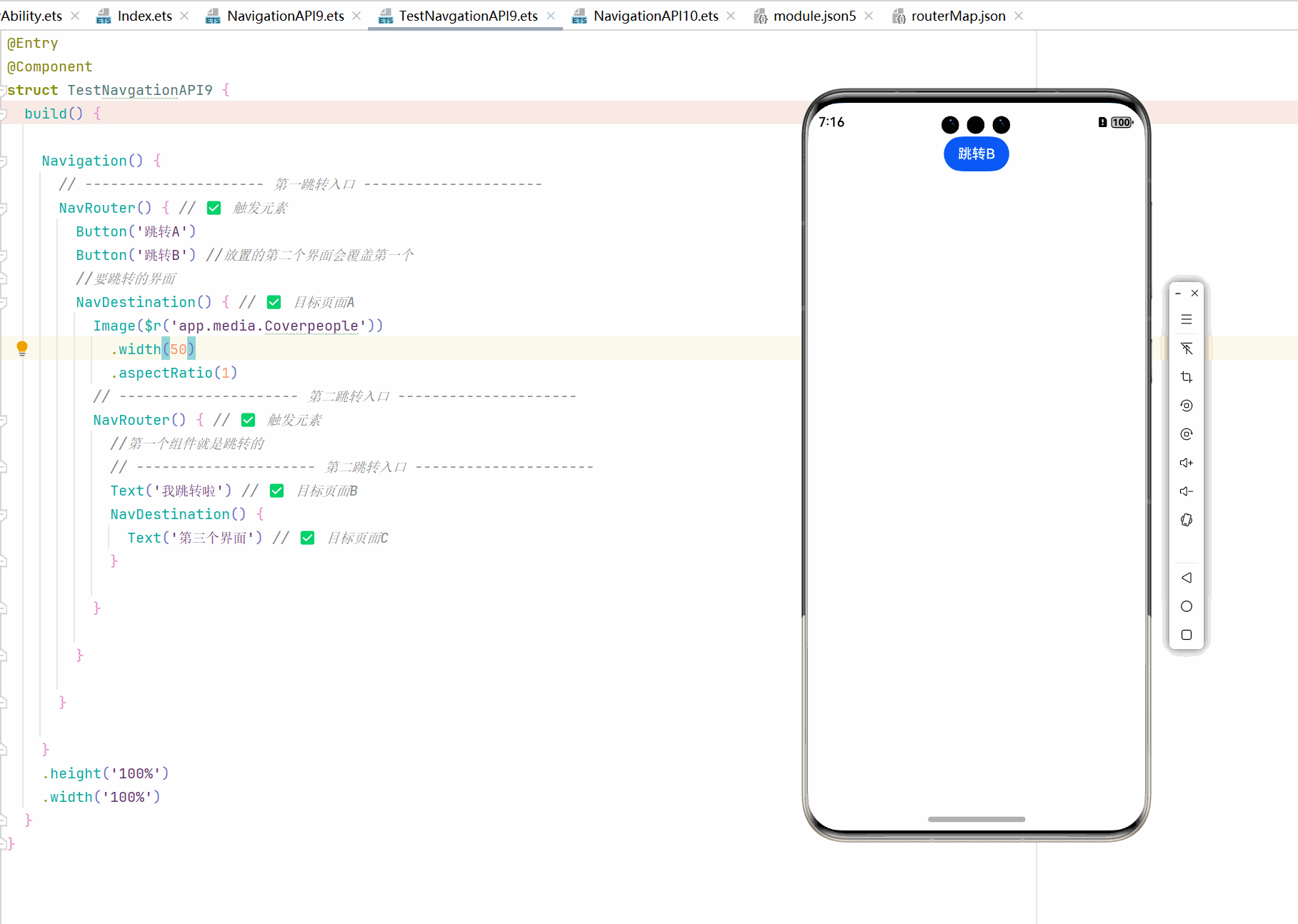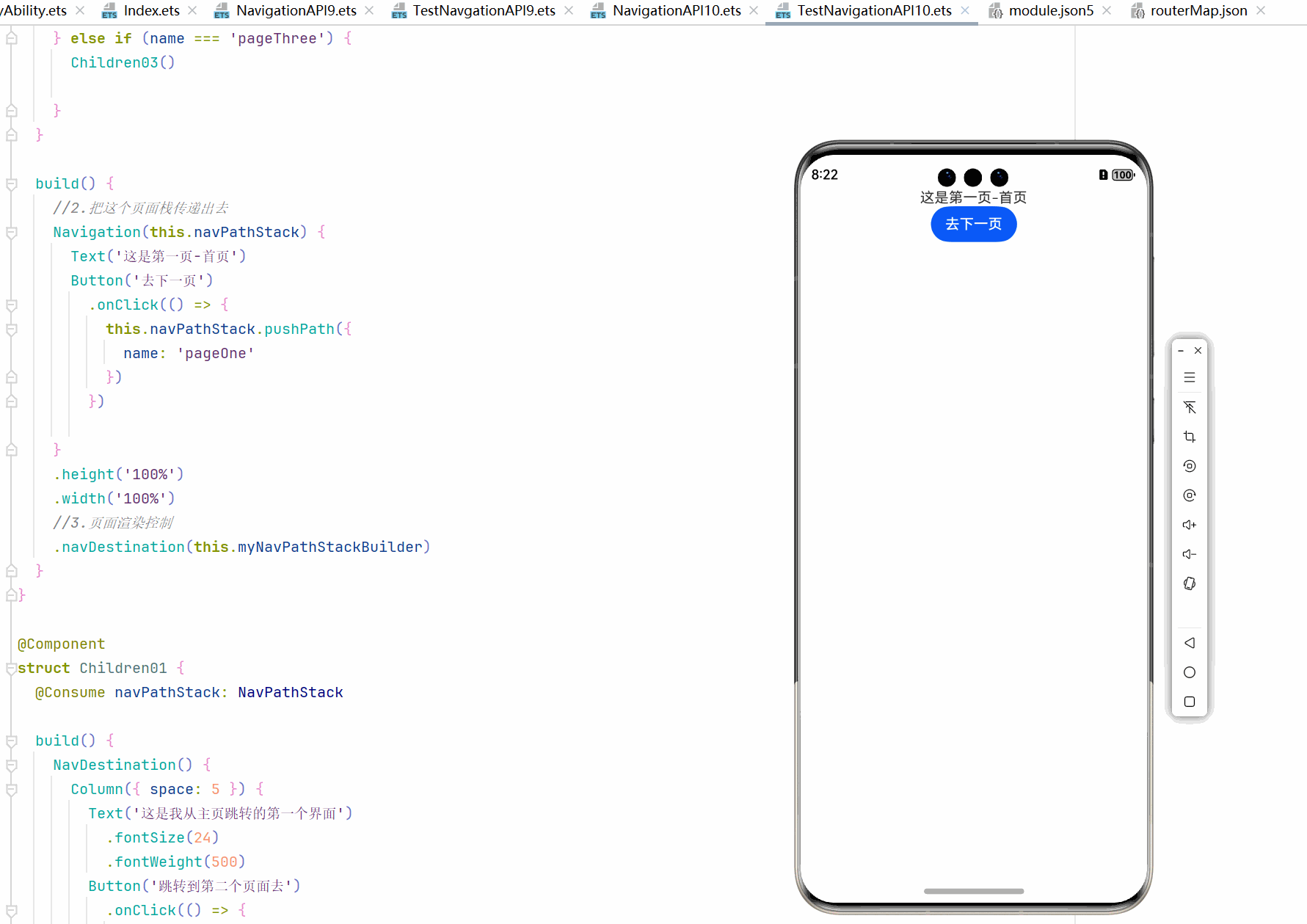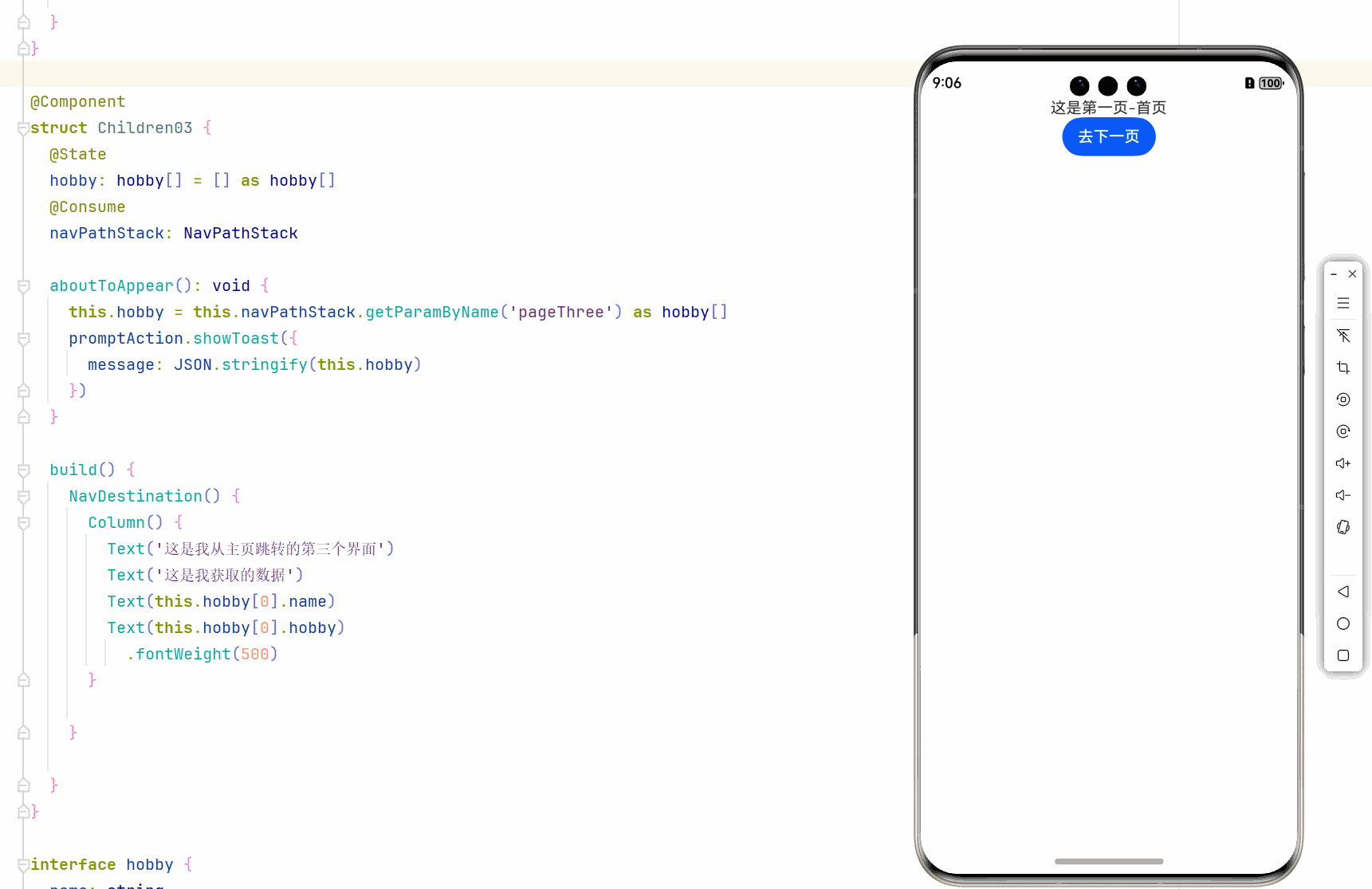Navagation基本用法
Navigation组件是路由导航的根视图容器,一般作为Page页面的根容器使用,其内部默认包含了标题栏,内容栏和公工具栏,其中内容区默认首页显示导航内容(Navigation的子组件)或非首页显示(NavDestination的子组件),首页和非首页通过路由进行切换
- 使用Navigation跳转的组件不需要再使用Entry来修饰,普通组件即可
- Navigation是一个导航组件,API9和API11的使用官方推荐方式各不相同
1. Navagation API9的用法-(Navigation-NavRouter-(其他组件+NavDestination的用法))
1. 1导航组件层次关系
| 组件 |
作用 |
层级规则 |
Navigation |
管理所有导航页面的根容器 |
必须包含多个 NavRouter |
NavRouter |
定义一个跳转入口 |
必须配对 NavDestination |
NavDestination |
目标页面内容 |
|
**1. **2 按钮覆盖问题
- 代码现象:
跳转B 覆盖 跳转A
- 根本原因:
在 NavRouter 内部放置多个直接同级组件时,仅最后一个组件会被渲染。
- ArkUI规则:
一个 NavRouter 只能关联 一个触发元素 (如Button),如需多个跳转需使用多个 NavRouter。
1.3 代码案例
1
2
3
4
5
6
7
8
9
10
11
12
13
14
15
16
17
18
19
20
21
22
23
24
25
26
27
28
29
30
31
32
33
34
35
| @Entry
@Component
struct TestNavgationAPI9 {
build() {
Navigation() {
NavRouter() {
Button('跳转A')
Button('跳转B')
NavDestination() {
Image($r('app.media.Coverpeople'))
.width(50)
.aspectRatio(1)
NavRouter() {
Text('我跳转啦')
NavDestination() {
Text('第三个界面')
}
}
}
}
}
.height('100%')
.width('100%')
}
}
|
1.4 效果展示

2.Navagation 10的用法
2.1 路由栈自主管理
NavPathStack
核心方法:
1
2
3
| pushPath()
replacePath()
pop()
|
2.2 页面加载控制
navDestination(builder)
通过 Builder 函数动态渲染路由目标:
1
| .navDestination(this.navDesBuilder)
|
1
2
3
4
5
6
| @Builder
navDesBuilder(name: string) {
if (name === "pageTwo") {
NavgationChild02()
}
}
|
2.3 跨组件通信
@Provide 与 @Consume 装饰器
1
2
3
4
|
@Provide navPathStack: NavPathStack = new NavPathStack()
@Consume navPathStack: NavPathStack
|
无需显式传递,自动向下注入。
2.4 实现步骤
1. 自己管理页面栈 创建一个页面栈 (用@Provide修饰,方便跨组件使用)
1
2
| @Provide
navPathStack: NavPathStack = new NavPathStack()
|
2.将创建的页面栈实例传递给主界面
ps:这一步还是蛮关键的,很多页面不展示就是这个原因
1
2
3
4
5
6
7
8
9
10
11
12
| Navigation(this.navPathStack) {
Text('这是第一页-首页')
Button('去下一页')
.onClick(() => {
this.navPathStack.pushPath({
name: 'pageOne'
})
})
}
.height('100%')
.width('100%')
|
3.通过 Builder 函数动态渲染路由目标
1. 先创建一个自定义Builder
1
2
3
4
5
6
7
8
9
10
11
12
13
14
15
| @Builder
myNavPathStackBuilder(name: string) {
if (name === 'pageOne') {
Children01()
} else if (name === 'pageTwo') {
Children02()
} else if (name === 'pageThree') {
Children03()
}
}
|
2. 传入Builder
1
| .navDestination(this.navDesBuilder)
|
不需要加括号,这里有个底层原因
- ArkUI 的
navDestination 机制
- 设计逻辑:框架需要在导航时动态调用构建函数生成页面。若传递this.navDesBuilder()则:
- 代码执行时立即运行该函数(而非按需调用)
- 返回结果可能为
void 或非组件类型,导致渲染异常。
@Builder 函数的特性
3.跳转的实现
- 通过点击事件调用当前
navPathStack实例pushPath方法
- 传入你要跳转页面的名字,进行跳转
1
2
3
4
5
6
| Button('去下一页')
.onClick(() => {
this.navPathStack.pushPath({
name: 'pageOne'
})
})
|
4.子界面的定义
1
2
3
4
5
6
7
8
9
10
11
12
13
14
15
16
17
18
19
20
21
22
23
24
25
26
27
28
29
30
31
32
33
34
35
36
37
38
39
40
41
42
43
44
45
46
47
48
49
50
51
52
53
54
55
56
57
58
59
60
61
| @Component
struct Children01 {
@Consume navPathStack: NavPathStack
build() {
NavDestination() {
Column({ space: 5 }) {
Text('这是我从主页跳转的第一个界面')
.fontSize(24)
.fontWeight(500)
Button('跳转到第二个页面去')
.onClick(() => {
this.navPathStack.pushPath({
name: 'pageTwo'
})
})
}
}
}
}
@Component
struct Children02 {
@Consume
navPathStack: NavPathStack
build() {
NavDestination() {
Column({ space: 5 }) {
Text('这是我从主页跳转的第二个界面')
.fontSize(24)
.fontWeight(500)
Button('跳转到第三个页面去')
.onClick(() => {
this.navPathStack.pushPath({
name: 'pageThree'
})
})
}
}
}
}
@Component
struct Children03 {
@Consume
navPathStack: NavPathStack
build() {
NavDestination() {
Column() {
Text('这是我从主页跳转的第三个界面')
.fontSize(24)
.fontWeight(500)
}
}
}
}
|
5.效果展示

3.NavagationAPI10使用的补充内容
3.1 常见的API
| 配置组合 |
代码示例 |
效果描述 |
| 默认状态 |
Navigation() .title('主标题') |
标题栏显示 “主标题”,采用 Free 模式 |
| 精简模式+隐藏标题 |
Navigation() .titleMode(NavigationTitleMode.Mini) .hideTitleBar(true) |
标题栏完全不可见 |
| 子页面独立配置 |
NavDestination() .title('子页标题') .hideTitleBar(true) |
|
3.2 传参获取参数的实现
1.定义数据结构
1
2
3
4
| interface hobby {
name: string,
hobby: string
}
|
2.即将跳转页面传入参数
1
2
3
4
5
6
7
8
9
10
11
12
13
14
| NavDestination() {
Column({ space: 5 }) {
Text('这是我从主页跳转的第二个界面')
.fontSize(24)
.fontWeight(500)
Button('跳转到第三个页面去')
.onClick(() => {
this.navPathStack.pushPath({
name: 'pageThree',
param: { name: '猫猫球', hobby: '喜欢玩毛线球' } as hobby
})
})
}
}
|
3.跳转的页面接收数据
1
2
3
4
5
6
7
8
9
10
11
12
13
14
15
16
17
18
19
20
21
22
23
24
25
26
27
28
| @Component
struct Children03 {
@State
hobby: hobby[] = [] as hobby[]
@Consume
navPathStack: NavPathStack
aboutToAppear(): void {
this.hobby = this.navPathStack.getParamByName('pageThree') as hobby[]
promptAction.showToast({
message: JSON.stringify(this.hobby)
})
}
build() {
NavDestination() {
Column() {
Text('这是我从主页跳转的第三个界面')
Text('这是我获取的数据')
Text(this.hobby[0].name)
Text(this.hobby[0].hobby)
.fontWeight(500)
}
}
}
}
|
4.效果展示




